Look up any use case to understand what it is based on and how to draw the AOIs for the most accurate benchmark comparison.
Digital advertising
Any digital advertising
Digital advertising refers to ads distributed through digital channels and platforms to deliver promotional messages to a target audience.
As the performance of an ad varies greatly depending on format and channel, we recommend comparing against the benchmark matching the specific use case of your ad such as display ads and social media ads.
This overall digital advertising category can however be used to compare against the average performance across any type of digital advertising.
Display ads
Display ads are ads that are embedded in a website or other digital platform. They can appear overlaid on content or at the side of the main content of the page. These ads need to be versatile to fit any environment, as they can be displayed in many different web contexts.
Image display ads are the most diverse in format and size. The benchmark for this category is based on banner ads without the website context, like the example below.
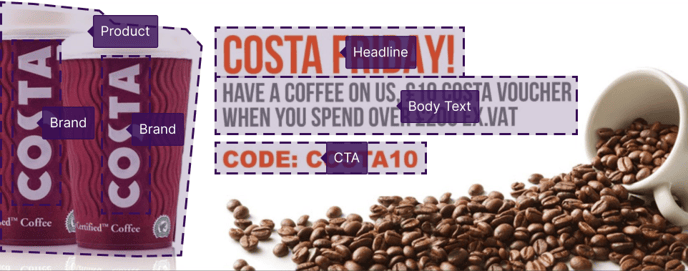
The example shows how the AOI types were drawn in the benchmark dataset, which can be used as a guideline when drawing AOIs to get the most accurate comparison to the benchmarked industry average.
Video display ads may be skippable or with call-to-action overlays. The aspect ratio for these ads is often landscape (16:9) like the example below, but different aspect ratios are also represented in the benchmark dataset.
Social media has become a predominant channel for small businesses and enterprises alike. Ads on social media are mainly viewed on mobile devices and typically on a screen of around 6.3 inches (16 cm), which makes the use of space and design critical to their success.
Image social media ads vary in performance across platforms, as people use them for different purposes. For this reason, we recommend comparing your ad against the benchmark for the specific platform it will be displayed on, which is currently available for Facebook and Instagram. This overall social media category can also be used to compare against the average performance across all platforms.
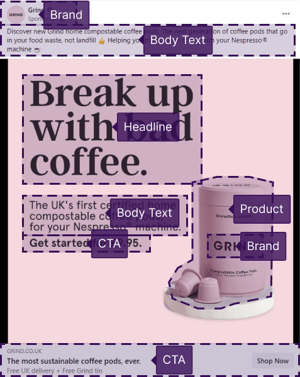
Additionally, these image benchmarks differentiate between in-context and out-of-context assets:
- In context: This benchmark consists of social media ads with the top and bottom of the post included. These post elements vary across the different social media platforms, and can be important to take into account when analyzing the performance difference.
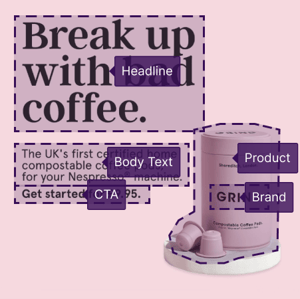
- Out of context: The default benchmark range of image and video assets is out of context, where only the creative is tested. As mentioned above the context of social media ads differs between platforms so before selecting the social media channel of the asset, use this benchmark range to get insights and recommendations for optimizing the creative and gauge the performance against others in that vertical.
Video social media ads have emerged as a powerful and dynamic tool for communication and marketing on social media. SoMe video ads come in various formats, such as square, landscape, and vertical, each tailored to the platform's unique aspect ratios and user behaviors. Our benchmark ranges include only creatives within the allowed aspect ratio for each platform to ensure the most representative sample of the SoMe video ad landscape.
For this reason, we recommend comparing your ad against the benchmark for the specific platform it will be displayed on. These platform specific benchmarks are currently available for Facebook, Instagram, TikTok, and YouTube. This overall social media category can also be used to compare against the average performance across all platforms.
These video benchmarks currently only include creatives out of context, meaning that none of the surrounding elements from the environment is included.
Facebook users are generally focused on social dynamics and have less focus on any particular element in a post. The creatives of ads on Facebook are key in gaining attention and engaging the audience with your ad. Making sure that branding, copy, and CTA are clear and effective is important for driving the efficiency of your ad.

Image Facebook ads are any standard format sponsored image ad appearing in the main Facebook news feed.
The benchmarks for this category is split into in context and out of context, depending on whether the surrounding post elements are included in the asset or not. For both benchmark, the creatives included in this category are both horizontal (1.91:1 or 16.9), square (1:1) or vertical (4:5), to best represent the different types of image ads on Facebook.
The example on the right shows how the AOI types were drawn in the benchmark dataset, which can be used as a guideline when drawing AOIs to get the most accurate comparison to the benchmarked industry average.
Video Facebook ads are any standard format sponsored video ad appearing in the main Facebook news feed.
To best represent the different type of video ads on Facebook, the benchmark dataset includes videos ranging from 3 seconds to 1 minute, and both horizontal (1.91:1, 16:9), vertical (4:5), and square (1:1) creatives.
Because the benchmark dataset for this category only includes creatives out of context, it can also be used for ads appearing in Facebook Marketplace, Facebook Stories, Facebook Live and Messenger, as they have comparable aspect ratios.
Instagram is a media-sharing platform, and the primary objective of its users is to experience photos and images, which makes the layout and the creative of the ad the primary importance.

Image Instagram ads are any standard format sponsored image ad appearing in the main Instagram feed.
The benchmarks for this category is split into in context and out of context, depending on whether the surrounding post elements are included in the asset or not. For both benchmark, the creatives included in this category are vertical (4:5, 9:16) or square (1:1) to best represent the different types of image ads on Instagram.
The example on the right shows how the AOI types were drawn in the benchmark dataset, which can be used as a guideline when drawing AOIs to get the most accurate comparison to the benchmarked industry average.
Video Instagram ads are any standard format sponsored video ad appearing in the main Instagram feed, not including influencer marketing or paid partnership videos.
To best represent the different type of video ads on Instagram, the benchmark dataset mainly includes videos ranging from 3 seconds to 30 seconds, and both vertical (4:5, 9:16) and square (1:1) creatives.
Although not explicitly collected for this purpose, this benchmark range can be used to gauge performance of Instagram reels or stories as well.
Dailymotion ads
Only available for videos
Dailymotion focuses on highly curated viewing experience and first-rate videos which resonate with viewers. Dailymotion advertising emphasizes brand safety, transparency and relevancy to the target audience to maximise viewability and completion. This benchmark category should be used to benchmark against recommended scores for this digital channel.
This category covers pre-roll, mid-roll, and post-roll video ads ranging from 6 seconds to 2 minutes and have a standard landscape (16:9) format.
TikTok ads
Only available for videos
TikTok ads have the potential to reach over 880 million people across the world. The short-form video platform showcases how the attention economy dominates discoverability, brand awareness raising and conversion. Catching in the first two seconds is crucial on TikTok for organic content and ads alike, so attention distribution and cognitive demand is of utmost importance.
This category covers any standard format sponsored video ads appearing in the main For You feed, not including any influencer marketing or paid partnership videos.
The TikTok benchmark dataset includes short form videos ranging from 3 to 30 seconds, which are exclusively vertical format (9:16) to best represent the usual content on TikTok.
Although not explicitly collected for this purpose, this benchmark range can be used to gauge performance of TikTok stories, Youtube Shorts and Instagram and Facebook Reels .
YouTube ads
Only available for videos
YouTube is considered the creator of the modern attention economy. Providing an avenue for both short-form and long-form videos and setting the standard for social media and online advertising alongside Facebook and Instagram. In pre-roll and in-feed ads the first seconds of attention are the most important to capture audience and deliver conversion, so even with the raise of short-form platforms, YouTube advertisement is thriving.
This category covers any standard format TrueView in-stream video ads, both skippable and unskippable, as well as bumper ads appearing on YouTube.
The YouTube benchmark dataset includes mostly videos ranging from 6 seconds to 1 minute and have a standard landscape (16:9) format.
Although not explicitly collected for this purpose, this category can be used for optimizing advertisement on any long-form video platform with in-stream video ads, e.g. Twitch and Facebook Gaming.
Traditional advertising
Any traditional advertising
Traditional advertising refers to offline advertising channels such as TV, out of home and print.
As the performance of an ad varies greatly depending on the type of advertising, we recommend comparing against the benchmark matching the specific use case of your ad such as out of home, print, and TV ads.
This overall traditional advertising category can, however, be used to compare against the average performance across any type of traditional advertising.
Note that if used for images, the "any" benchmark will include both out of home and print ads, while the any benchmark for videos will provide the ranges based on TV video assets.
Out of home ads
Only available for images
Out of home (or OOH) ads can take many different formats and appear in a variety of locations, such as on the side of a building, a bus stop, the roadside, in a mall, or on a vehicle.
The wide variety of locations, viewing angles, and lighting conditions that an outdoor ad can be seen in means that the viewing context of a creative can vary considerably. Testing the performance of different contexts is therefore important, which is why the benchmark of this category consists of ads in the out of home context, like the example below.
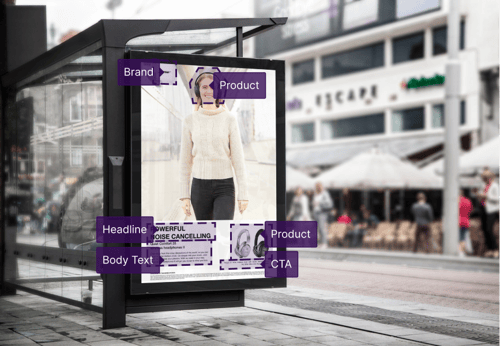
The example shows how the AOI types were drawn in the benchmark dataset, which can be used as a guideline when drawing AOIs to get the most accurate comparison to the benchmarked industry average.
Print ads
Only available for images
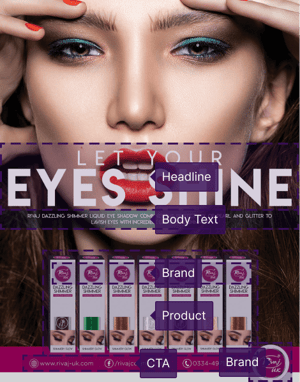
Print ads are printed in hard copy in publications such as newspapers, magazines, and mailers. They typically occur in a landscape or portrait format and include an image, headline, branding, and body text.
Print ads are usually required to be effective in several different media and therefore need to be more versatile. For this reason, the benchmark for this category is based on context-independent print ads like the example shown to the right, where the surrounding environment has been excluded.
The example shows how the AOI types were drawn in the benchmark dataset, which can be used as a guideline when drawing AOIs to get the most accurate comparison to the benchmarked industry average.
One of the most enduring traditional advertising channels is the TV ad. TV advertising continues to be a key marketing tool and offers wide reach, emotional impact, trustworthiness, and captive audiences.
The TV benchmark dataset includes videos ranging from 15 seconds to 2 minutes and have a standard landscape (16:9) format to represent the usual advertising seen on TV.
Products
Any products
This category includes all packaging assets as well as additional product assets. As the Neurons AI benchmark categories grow, this category would also include product designs and assets depicting product in and out of use.
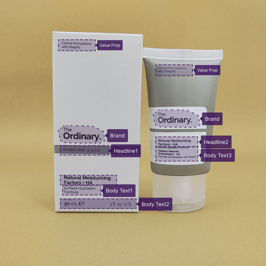
Packaging
This category shows product packaging being displayed on a white, transparent or neutral background.
This category is only available for images, and the dataset includes mostly examples of individual packaging designs or designs of a number of products packaged together.
Websites
All websites
Websites come in a nearly endless variety and have many different purposes, such as sharing news, entertainment, selling products, communication, and many more. The components of a website are typically a combination of written content and other media, but there are no definite rules for how a website should be structured.
There are however similarities across websites with the same purpose, which is why we have created specific benchmarks for some of the most common types of websites: Brand sites and e-commerce sites.
We recommend using one of the type-specific benchmark categories for the most accurate performance comparison to the industry standard. If your website doesn't match any of the categories, you can use this overall website category to compare against the average performance across any type of website.
All benchmarks for websites represent landing pages views on a standard desktop resolution without any browser navigation and popups.
Brand websites
The main purpose of a brand website is to provide effective communication with customers, and inform customers about the company’s activities and the range of services provided. In addition, they can be used to establish the brand’s purpose and emotional connection with its audience, increase credibility, and build interaction with consumers and within the company.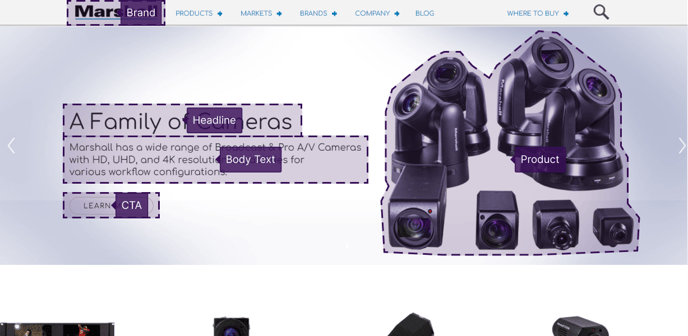
The example shows how the AOI types were drawn in the benchmark dataset, which can be used as a guideline when drawing AOIs to get the most accurate comparison to the benchmarked industry average.
E-commerce websites
This category is for websites that are used for the sale of products or services from multiple different brands. These types of websites are primarily made for facilitating the discovery, selection, and purchase of products, and are therefore designed with the express purpose of enabling a transaction. The display of imagery and text around product features is therefore of primary importance. 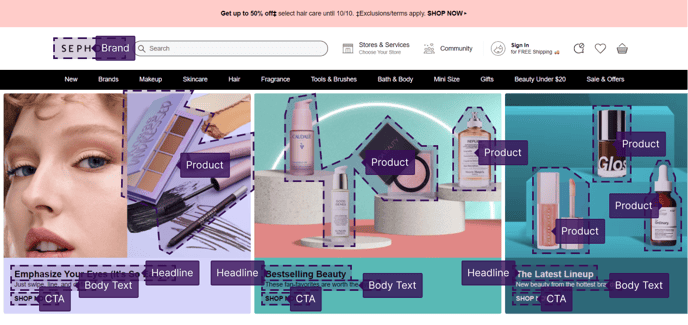
The example shows how the AOI types were drawn in the benchmark dataset, which can be used as a guideline when drawing AOIs to get the most accurate comparison to the benchmarked industry average.
Overall
Any use case
This benchmark will show you the average performance across all our other benchmark use case categories for websites and advertising.
It is always recommended to use the specific benchmarks matching your asset to see the average performance for your use case, but this overall category can be used if your creative doesn't fit within any of the specific categories, or if you just want to compare against the performance across any use case.
